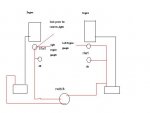Okay I haev my new to me boat in the water and am trying to figure out this battery wiring the last owner had going on.
I have had dual Batts to a single motor which is pretty straight forward. This has twin engines as well yet he is running 2 batts and 1 batt selector switch and as I side note there are 2 altermators.
When I hook up just the right batt nothing will work. Hook up just the left batt and power is had on select batt 1. Hook up both and I can select between batts, I beleive it is selecting anyhow.
The left batt also has a Pos lead directly to the starter post. While working on a broken oil sender wire I had the right engine harness unpluged and had nothing on the dash working from either Batt so I am assuming the dash control is from the right engine harness.
The left cranks very well which would make sense as it has a short lead from the left Batt to the starter post. The right engine cranks very slowly with new Batts and the Pos lead is getting warm. It does not have a short lead from the Batt to the starter post as I assume this would render the switch useless. The lead is a pretty long run from the right Batt to the switch and then back to the right starter post hence some of the heat and voltage drop.
Mind you with the direct run on the left Batt to the left starter post not sure you could ever not start that motor from that Batt.
Does anyone have a wire diagram for a common setup with dual Batts, twin engine and only 1 switch?
Hope some of this makes some sense as I have not drawn it out.
I have had dual Batts to a single motor which is pretty straight forward. This has twin engines as well yet he is running 2 batts and 1 batt selector switch and as I side note there are 2 altermators.
When I hook up just the right batt nothing will work. Hook up just the left batt and power is had on select batt 1. Hook up both and I can select between batts, I beleive it is selecting anyhow.
The left batt also has a Pos lead directly to the starter post. While working on a broken oil sender wire I had the right engine harness unpluged and had nothing on the dash working from either Batt so I am assuming the dash control is from the right engine harness.
The left cranks very well which would make sense as it has a short lead from the left Batt to the starter post. The right engine cranks very slowly with new Batts and the Pos lead is getting warm. It does not have a short lead from the Batt to the starter post as I assume this would render the switch useless. The lead is a pretty long run from the right Batt to the switch and then back to the right starter post hence some of the heat and voltage drop.
Mind you with the direct run on the left Batt to the left starter post not sure you could ever not start that motor from that Batt.
Does anyone have a wire diagram for a common setup with dual Batts, twin engine and only 1 switch?
Hope some of this makes some sense as I have not drawn it out.




















